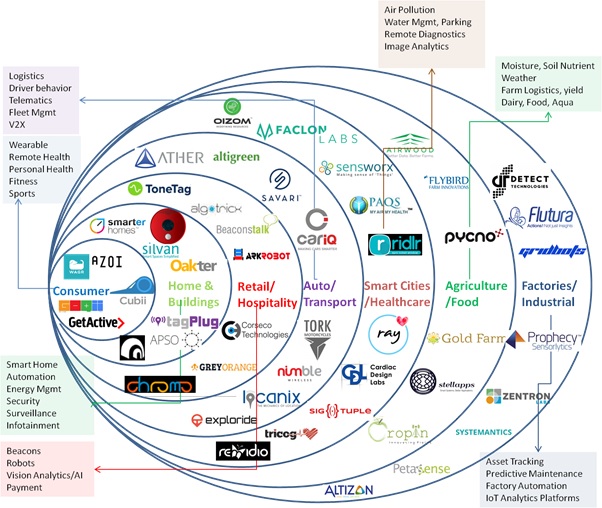By Sanjay Anandaram, TiE Bangalore Governing Board Member
 India is globally recognised and respected for its prowess in Information Technology services. Companies like TCS, Infosys, Wipro and many others have become enormously influential in the world of IT by building high quality, highly capable multi-billion dollar franchises. Indian IT generates about $170+billion in revenues and employs about 4million people. Increasingly, India with over 30 unicorns, over 500,000 employed and 50,000 startups, is also recognised as a leading global startup hub. Indian startups are building brands in India and overseas with the likes of Zoho, Druva, InMobi and Freshworks leading the pack.
India is globally recognised and respected for its prowess in Information Technology services. Companies like TCS, Infosys, Wipro and many others have become enormously influential in the world of IT by building high quality, highly capable multi-billion dollar franchises. Indian IT generates about $170+billion in revenues and employs about 4million people. Increasingly, India with over 30 unicorns, over 500,000 employed and 50,000 startups, is also recognised as a leading global startup hub. Indian startups are building brands in India and overseas with the likes of Zoho, Druva, InMobi and Freshworks leading the pack.
Since 1991, the IT and startups ecosystems are on a well-established growth trajectory. This has occurred over time and thanks to the sustained effort, awareness generation and education initiatives of very many people. As a country, creating multiple growth engines for value creation and jobs is an imperative.
What Next?
The next big opportunity for India is in the area of Internet of Things (IoT) which has applications across sectors which is estimated to be over $500b by 2022. It is an amalgam of hardware, embedded software, sensors, AI, networks and management. It requires the coming together of multiple capabilities, technologies, policy, legal frameworks (eg data security and flows for Machine to Machine communications), talent, hardware manufacturing and product design. India with its huge scale of challenges and opportunities can be a serious leader and contributor to this fast emerging and evolving world of IoT.
What needs to be done?
The well established paradigm for influencing the world substantively is through the creation and collaboration across relevant institutions, standards and markets. The West and now China understand this well. For Indian IoT to take advantage of the opportunities ahead, it needs to use this same paradigm and the playbook of the other successful industries and countries. Industry groups like Nasscom and iSpirt have shown, in different circumstances and times using different models for different end goals, how Indian industry players can organize themselves. Given today’s context and the needs of the IoT industry, a new model for engagement perhaps needs to emerge.
China has shown how it has seized the advantage in 5G, batteries and other areas.
A 3-pronged approach
First, the setting up of standards is an important area that needs attention. There is a strong first mover advantage in the world of technology standards and rule setting. China, for example, has an IoT Reference Architecture (RA) that is likely to be accepted by the international community as the ISO/IEC 30141 made by the WuXi IoT Research Institute. The RA was in the works since 2013 with China, US, Britain, Japan, Sweden competing for establishing a standard. China adopted the same approach in setting the rules for 5G over a decade ago. India needs to adopt a similar approach for 6G since the 5G train has well passed. 6G will lead to smaller, energy efficient, AI enabled devices with implications for defence, space and drones and multiple sectoral applications. Can India set a multivendor IoT (mvIoT) standard? Can it innovatively leverage WANI 2.0 (WiFi Access Network Interface) as has been argued ? Participating in ISO, ITU and IEEE standards bodies is critical. The role of technology experts, academia and industry participants has to be enlisted.
Second, the importance of “markets”. Namely, leveraging the size and scale of the Indian market to get leading foreign companies to participate in India while conforming to Indian standards. Creating market opportunities through the right policy interventions to create markets and strong companies. The power of markets can be used to negotiate deals and opportunities in overseas markets. This will require a lot of education, awareness generation, evangelization and collaboration. All of which will require an institutional framework to operate in. China has successfully shown how to strategically use the power of their massive market.
The third and equally, if not more, important aspect involves the setting up of an Indian entity exclusively for IoT consisting of Indian companies – large and small – with a clear charter for furthering IoT in and from India. The staffing, funding and governance of this entity has to be such to ensure independence while driving the agenda. The entity should have separate and several expert groups working on policy, technology, laws, partnerships, education, certification, awareness generation and the like.
The enthusiastic reception of forums like IoTNext over the past few years has shown that India has the necessary ingredients to be to be a serious global player in IoT. It now needs to set itself up global success through the creation of the mutually reinforcing mechanisms of institutions, standards and markets.
[ Editors Note : IoTNext 2019 Panel will be exploring this thesis on Dec 2, 2019]
